 |
 |
 |
| |
Genital HIV-1 RNA Concentrations and Heterosexual HIV-1 Transmission Risk: 'higher genital HIV levels increase HIV sex transmission risk'
|
| |
| |
Reported by Jules Levin
5th IAS Capetown July 19-22 2009
Jared Baeten1, Erin Kahle1, Jairam R. Lingappa1, Robert W. Coombs1,
Deborah Donnell2, Anna Wald1,2, Lawrence Corey1,2, Connie Celum1
for the Partners in Prevention HSV/HIV Transmission Study Team*
From the 1University of Washington & 2Fred Hutchinson Cancer Research Center, Seattle, USA
*Partners in Prevention HSV/HIV Transmission Study Team members listed below
Author Conclusions
Higher genital HIV-1 RNA concentrations are associated with greater risk of heterosexual HIV-1 transmission, which validates genital HIV-1 levels as a surrogate marker of HIV-1 transmission risk.
Background
Plasma HIV-1 RNA concentrations are associated with risk of heterosexual HIV-1 transmission.
Studies have demonstrated a strong correlation between plasma and genital HIV-1 concentrations but have not explored the relationship between genital HIV-1 levels and HIV-1 transmission risk.
Study Population
In a clinical trial of acyclovir suppressive therapy among HIV-1/HSV-2 co-infected partners within African HIV-1 serodiscordant couples, genital specimens were collected for HIV-1 RNA quantification.
A semen sample was provided by male HIV-1 infected partners once during follow-up, and an endocervical swab was collected from female HIV-1 partners 6 months after enrollment. Only genital samples collected when participants did not report ART use were analyzed.
Of 3408 HIV-1 serodiscordant couples enrolled in the clinical trial, 2521 (74.0%), including 1805 of 2299 couples with HIV-1 seropositive women (78.5%) and 716 of 1109 couples with HIV-1 seropositive men (64.6%), were eligible for this analysis.
- Primary reason for non-inclusion was no genital sample provided.
Follow-up and HIV-1 Seroincidence
· 3509 person-yrs of follow-up to assess HIV-1 seroincidence among HIV-1 seronegative partners.
· 113 partners (73 men and 40 women) seroconverted to HIV-1 (incidence 3.2 per 100 person-years).
· Of these incident HIV-1 infections, 78 (69.0%), including 46 among men (63.0%) and 32 among women (80.0%), were determined by viral sequencing to be genetically linked within the partnership.
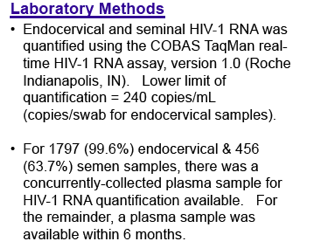
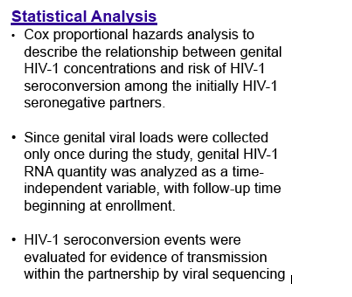
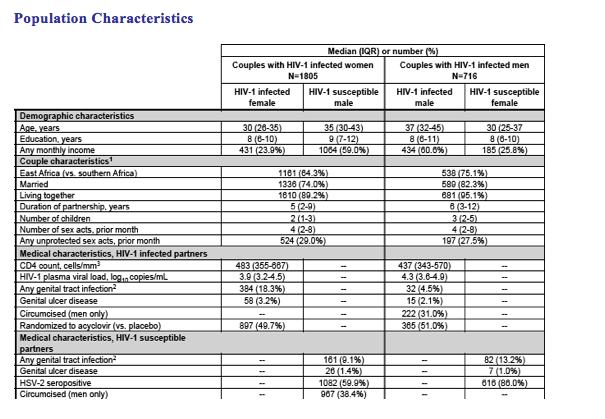
Detection and quantity of genital HIV-1 RNA
HIV-1 RNA was detected in 1081 (59.9%) of endocervical swab samples. The median endocervical HIV-1 concentration was 3.20 log10 copies/mL (IQR 2.08-3.87) overall and 3.74 log10 copies/mL (IQR 3.33-4.24) among those with detectable levels.
In semen, HIV-1 RNA was detected in 404 (56.5%) of samples, and the median HIV-1 concentration was 2.57 log10 copies/mL (IQR 2.08-3.60) in all samples and 3.44 log10 copies/mL (IQR 2.92-4.12) among those with detectable levels.
Genital HIV-1 concentrations were significantly lower among those randomized to acyclovir versus those randomized to placebo: median 2.98 vs. 3.29 for endocervical swabs (p<0.001) and 2.38 vs. 2.76 for semen (p=0.008).
Figure 1. Genital HIV-1 RNA concentrations were higher among HIV-1 transmitting couples, compared with nontransmitting couples:
For both men and women, p<0.001 for comparison
of those transmitting vs. non-transmitting HIV-1
Also, for both men and women, there was no statistically significant difference for those with genetically unlinked transmissions (i.e., in which HIV-1 seroconversion occurred, but from an "outside" partner) vs. those who did not transmit HIV-1. [This supports the accuracy of the viral linkage methodology and the relationship between genital HIV-1 and transmission risk.]
Plasma & genital HIV-1 RNA levels were modestly correlated:
Spearman's p=0.56 (p<0.001) among women &
p=0.55 (p<0.001) among men.
The first column in these 2 panels were transmitters showing transmitters had higher genital HIV levels either endocervical levels for female-to-male transmission or semen levels for male-to-female transmission.
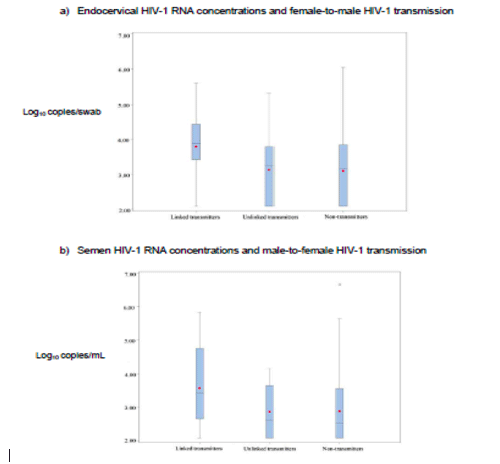

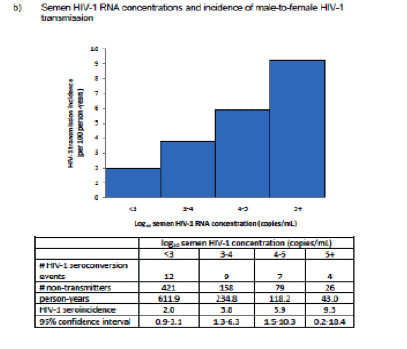
Among 724 couples with HIV-1 infected women who had undetectable HIV-1 endocervical RNA concentrations, there were 7 HIV-1 transmission events (incidence 0.5 per 100 person-years, 95% CI 0.2-1.2).
Among 311 couples with HIV-1 infected men who had undetectable semen HIV-1 RNA concentrations, there were 4 HIV-1 transmission events (incidence 0.9 per 100 person-years, 95% CI 0.2-1.8).
Conclusions
Higher genital HIV-1 RNA concentrations are associated with greater risk of heterosexual HIV-1 transmission, which validates genital HIV-1 levels as a surrogate marker of HIV-1 transmission risk.
|
| |
|
 |
 |
|
|